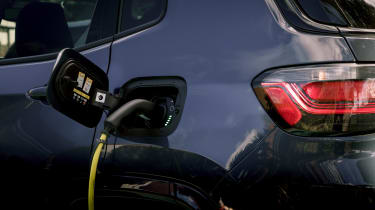Jeep Compass SUV - Engines, drive & performance
Trailhawk model has off-road prowess, but rivals are better on tarmac
The Jeep Compass is impressive off-road, capable of tackling terrain including rocks, gravel, and whatever else is thrown at it.
It’s likely, however, that Compass owners in the UK will rarely make use of the car’s all-terrain prowess, preferring to stay on tarmac – and here the Compass lags behind many of its rivals. Its steering is very light and lacks feel, and the car leans and understeers more than the Ford Kuga or Mazda CX-5. This is exacerbated by the all-season tyres fitted to the Trailhawk model, which only come into their own once you hit the dirt or the weather gets bad.
Off-road, the tables are turned and the Compass Trailhawk's only rival is the Land Rover Discovery Sport. Jeep's Active Drive Low system gives the Compass a 'crawling ratio' to tackle steep inclines and its clever four-wheel drive can send all the engine's power to just one wheel if necessary. Selec-Terrain provides Snow, Sand, Mud, Rock and Auto driving modes, with the Rock setting exclusive to the Trailhawk. Taller suspension, underbody shielding, new bumpers and a red tow hook hint at its off-road ability.
Jeep Compass petrol engine
Entry-level models used to be offered with a 128bhp 1.3-litre petrol engine, but as of Spring 2023, all Compass models use at least some form of mild hybrid technology. e-Hybrid models use a 128bhp 1.5-litre petrol engine paired with a 0.8kWh battery and 19bhp electric motor, combined with a seven-speed automatic gearbox. You can’t travel significant distances on electric power alone, but the electric motor is used on startup and can handle low speed manoeuvres when parking and in stop-start traffic. The engine shuts down when you’re coasting, too.
Hybrid engines
The Compass 4xe is the plug-in hybrid model – this uses a 178bhp version of the 1.3-litre engine joined by an electric motor for a total output of 237bhp, and the plug-in Jeep Compass can get from 0-62mph in a nippy 7.5 seconds.
Not that it feels that fast in the real world because the gear changes made by the six-speed automatic are too sluggish. It’s slow to kick down when you want to accelerate and the electric motor doesn’t fill the gap. We found the 4xe to be quite noisy if you want to get up to speed quickly; it’s clear a more relaxed driving style is intended.
Diesel engines
Previous engines have included a 1.6-litre diesel with 115bhp, plus a 2.0-litre diesel with either 138bhp or 168bhp. The latter, reserved for top-spec cars, got a nine-speed automatic gearbox and was smooth to drive but this gearbox had a tendency to hang on to gears for too long. A 1.4-litre petrol engine was available in the same outputs as the bigger diesel.










